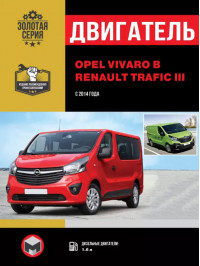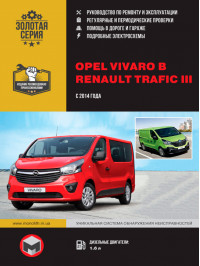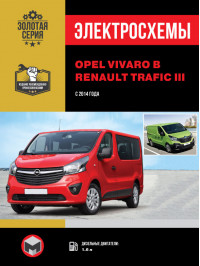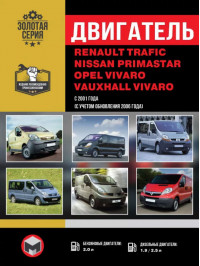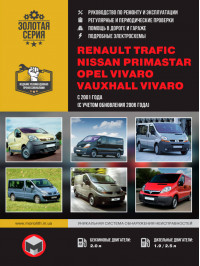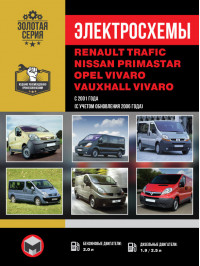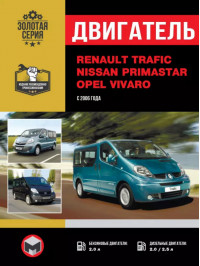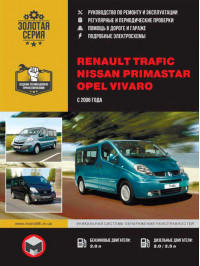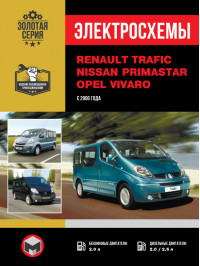Information on repair and maintenance of Renault Trafic cars electronically
The Renault Trafic is a minibus or medium-sized van produced by the French manufacturer Renault since 1980. It is also sold under the Vauxhall, Nissan, Opel, Mitsubishi Motors and Fiat brands. Its main competitors are the Sevel, Volkswagen Transporter, Ford Transit Custom and Mercedes-Benz Vito mid-size vans.
The Renault Trafic is available with front- or rear-wheel drive and numerous body configurations including three-seat without glass, nine-seat and chassis cab. The name "Trafic" is a French word meaning "trade" or "traffic".
Renault began producing front-wheel drive delivery vans in the late 1950s. An important milestone was the appearance of the first generation of cars called Trafic in 1980.
This generation included a variety of models, such as front-wheel drive frame-supporting vans, minibuses, platform chassis and flatbed trucks with T indexes. In addition, frame rear-wheel drive flatbed trucks and chassis with cabs under the P index were developed. Since 1985, the family has also included four-wheel drive minibuses and trucks.
Renault Trafic (after the Renault EF, Renault GS, Renault KZ, Renault Primaquatre, Renault Colorale and Renault Estafette) combines all three modern drive types. The family is also divided into five different options based on gross weight and, accordingly, load capacity. For example, front-wheel drive T800 vans have a gross weight of 2100 kg and a load capacity of 800 kg, T1000 - 2300 and 1000 kg, and T1200 - 2700 and 1200 kg, respectively.
Rear-wheel drive P1300 trucks have a payload capacity of 1,275 kg (1,450 kg), and all-wheel drive V trucks have a payload capacity of 2,550 to 2,700 kg and 1,150 to 1,300 kg, depending on body type.
The overall dimensions of the short-wheelbase van are: length 4542 mm, width 1905 mm and height 2018 mm (with a regular roof) or 2424 mm (with a “high” roof). The useful volume is respectively 5.3 and 6.6 m3. With a base of 3200 mm, the overall length increases to 4942 mm, and the capacity varies from 6.3 to 7.8 m3. The 4x4 model has a useful volume of 7.2 m3.
To achieve a better load on the front drive axle, the engines in Renault Trafic cars were installed longitudinally. Starting in 1984, the main engine was a carburetor 1.4-liter engine with a power of 48 horsepower. Later, in 1984, they began to install a more powerful 1.65-liter engine with a capacity of 65 horsepower, available with a 5-speed manual transmission or a 3-speed automatic transmission. Since 1987, a 1.7-liter engine with 68 horsepower has appeared, and on the all-wheel drive model you can find a 2.0-liter engine with 82 horsepower.
The installation of diesel engines (2.1 liters, power 65 horsepower) led to a change in the design of the front of the car due to a more bulky power unit, which required moving the radiator grille forward.
In 1987, the T1200 was renamed T1300 due to an increase in lifting capacity by 100 kg.
The first significant modernization of the Renault Trafic's exterior occurred in 1989, including changes to the front of the car such as the bonnet, fenders, headlights and grille. The design and finishing of the seats have also been improved, the cabin sound insulation has been improved, and the load capacity of all models has been increased by approximately 100 kg. The models were renamed T900, T1100 and T1400. The main engines were diesel: 1.9 liters with a power of 61 horsepower and 2.5 liters with a power of 76 horsepower, as well as a 2.2-liter injection engine. A year later, models included a radio with in-door speakers as standard equipment and improved interior trim on vans.
Thanks to new cooperation partner General Motors Europe, the second generation was also built as the Opel Vivaro and Vauxhall Vivaro. Following the launch, the Renault Trafic II and Opel Vivaro were both voted 'Van of the Year' in 2002. Thanks to the Franco-Japanese Renault-Nissan alliance, the van was also sold as the Nissan Primastar. Renault Trafic II, Nissan Primastar and GM variants were produced at GM Manufacturing Luton.
It is important to have access to information about vehicle repairs and maintenance, especially if you own a Renault Trafic. Renault Trafic repair manuals in PDF format, which you can read and buy on our website for free, will be very useful for you. They will help keep your car in good condition and solve some minor breakdowns yourself.
They contain detailed instructions for various types of maintenance and repair, as well as answers to many questions, for example:
- how to replace the oil filter;
- how to replace brake pads and discs;
- how to find a fault defective elements of the vehicle lubrication system and eliminate it;
- how to properly remove, replace and repair a muffler, etc.
The Renault Trafic car repair book can be downloaded not only to your computer, but also to your smartphone or tablet. She will always be at hand and will help you out in any unclear situation.
Having access to this information can save you time and money by allowing you to perform some maintenance work yourself.



